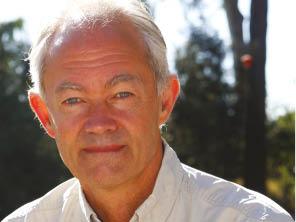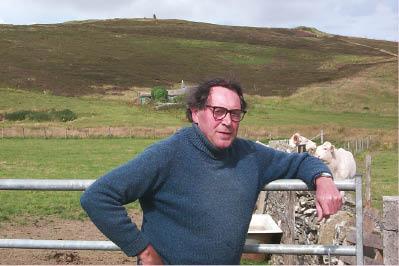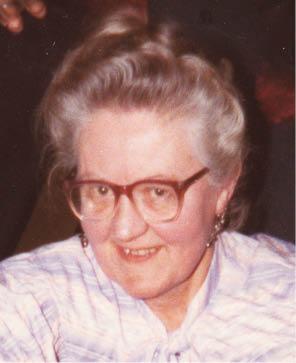Several distinguished archaeologists who had close links to the Institute have died during the past year. Brief obituaries are given here and reference made to some of the obituaries available elsewhere.
Professor Simon Keay, FBA, 1954–2021
I first met Simon Keay (Figure 1) in 1988 when I was a student at Southampton University taking their new MSc in Archaeological Computing. Although I was never taught by Simon, he was very open and helpful with my research interests; when I was working subsequently on my PhD, his aid in dealing with the Spanish material was invaluable. Although I never had the pleasure of working on his fieldwork projects, many of my friends and colleagues did and are universal in praise of his kind leadership.
Simon was born in London to Antony and Lorelei Keay. He undertook his BA at the Institute in 1974–77, taught by Richard Reece, John Wilkes and Mark Hassall. It was there that he met his lifelong friend and fellow Roman archaeologist Martin Millett. During his undergraduate degree Simon excavated in Italy, including at Sette Finestre, as well as in the UK. His undergraduate dissertation, entitled ‘Coins of Verulamium: A quantitative study’, is fascinating for me now as it combines three of my main research interests, although this was not a field of study that Simon pursued further.
He was awarded a British Academy Scholarship for his PhD on late Roman amphora, particularly from Catalonia. It was supervised by John Wilkes, completed in 1983 and published by British Archaeological Reports (BAR) in 1984. While he was working on his PhD, Simon was part of a joint UK-Catalan team investigating the villa of Vilauba and its region. The project included excavation, field survey and geophysics, aspects which became a feature of Simon’s many future research projects.
Simon was appointed to a lectureship in Iberian archaeology at the University of Southampton in 1985, publishing his book on Roman Spain in 1988. He was promoted to Senior Lecturer in 1994 and Professor in 1997. Simon became Research Professor of archaeology at the British School in Rome in 2006 and was elected a Fellow of the British Academy in 2016. He retired from the University of Southampton in 2020.
Following his appointment at Southampton, Simon developed a series of research projects in Spain, including Peñaflor (1987–92) and Italica (1991–93). At Italica he was to undertake a geophysical survey of the town, along with John Creighton and José Manuel Rodríguez Hidalgo. Through the 1990s the capabilities of geophysical survey equipment and data processing capabilities improved sufficiently to allow surveys to extend to whole landscapes. Simon was an enthusiastic advocate for geophysics; many of his projects featured large-scale surveys such as that in 1997 at Falerii Novi in Italy. Southampton’s position as a centre of excellence for computing in archaeology enabled him to incorporate new technologies such as GIS, 3D modelling and the semantic web into his projects.
From the mid-1990s on Simon began to work more extensively in Italy. Never afraid of a ‘big project’, he took on the geophysical and field survey of Portus, some 200 hectares (494 acres), followed by a series of further research projects, including excavation. It is his work at this key site for the understanding of the Mediterranean economy for which he is now probably best known. This led to the European Research Council-funded Portus Limen project (2014–19), which investigated a network of 30 ports across the Mediterranean.
Simon’s linguistic skills, diplomacy, willingness to include emerging methodologies and support early-career researchers, as well as his extensive knowledge of the Roman world, allowed him to have an outstanding academic career. However, he will also be remembered for his kindness and sense of humour. He is survived by his wife Nina and his sons James and Leo.
Dr Kris Lockyear
UCL Institute of Archaeology
For further obituaries, see:
https://www.theguardian.com/science/2021/may/09/simon-keay-obituary
Adrian Challands, 1944–2020
The 1980s saw an expansion in the employment of different geophysical techniques. One of their main UK proponents was Adrian Challands (Figure 2), a graduate of the Institute of Archaeology when it was an independent institute of the University of London. Initially working in the Fenlands, Adrian undertook large magnetic susceptibility surveys at the Neolithic causewayed enclosure of Etton and other partially buried prehistoric fenland landscapes, mainly around the Maxey area of north Cambridgeshire. However, it was in Orkney that he undertook an exceptional range of geophysical surveys on and around renowned Neolithic and Bronze Age sites. In the mid-1980s the discovery of the Barnhouse late Neolithic settlement – adjacent to the Stones of Stenness stone circle – led to large magnetic susceptibility and resistivity surveys being undertaken. These not only defined the areas of occupation, but also located the stone-socket of the famed Stone of Odin, demolished in 1814. The Stone itself was broken up and taken to the farm of Barnhouse, the holed section serving as an anchor for a later horse mill there.
Adrian’s specialism in geophysical survey was much in demand, both for large-scale surveys and for the much smaller analysis of excavated Neolithic house floor surfaces. Consequently he continued to be involved in numerous important archaeological projects in Orkney, from the late 1980s to the present. Together with Richard Jones, Adrian expanded out into pioneering geophysical and geochemical analyses of house floors and settlements at a number of newly discovered Neolithic and Chalcolithic sites, including Stonehall, Crossiecrown and Wideford Hill.
Adrian’s archaeological geophysical surveys also included well-known Orkney ceremonial sites. Among them were the Maeshowe passage grave, where he discovered stone-holes of standing stones on the platform that had been subsequently removed, and the Ring of Brodgar henge, where he was able to demonstrate that the monoliths (many now missing) increased in number towards the two entrances, visually to impress those entering the great ring. At the famous Knowes of Trotty Bronze Age barrow cemetery Adrian, together with his wife Norma, undertook a very difficult survey (in the heather and boggy ground). Here he discovered a number of new burials and an early Neolithic house, subsequently excavated.
Adrian loved Orkney and its fabulous archaeology. He not only made a huge contribution to its prehistory from the 1990s, but also formed many friendships during annual visits to the isles and long periods of fieldwork. While Adrian’s focus lay in Orkney, in more recent times he and Norma joined the Rapa Nui Landscapes of Construction Project (based at UCL) for a season. In doing so he carried out the first geophysical survey of Puna Pau, Easter Island’s statue hat quarry.
All those who knew Adrian will testify to his singularity and good humour.
Colin Richards
Archaeology Institute, University of the Highlands and Islands
For a further obituary, see:
https://www.nenevalleyarchaeology.co.uk/post/obituary-adrian-challands
Heather Bell, 1920–2020
Heather Margaret Bell (Figure 3) died in Putney on 27 October 2020, two months short of her centenary. She was born on 21 December 1920, the youngest child of Cyril Francis Bell and his wife Phyllis. An older brother did not survive infancy; her sister Bethia Nancy, known as Nancy, was born in 1918. Although born in England, Heather spent her earliest years in Burma (where her father worked for the Imperial Forest Service), until the family returned to London in 1925. She and Nancy lived for the rest of their lives in a house by Putney Common, for many years with their mother and later with lodgers.
Heather had a history degree from the University of London, although she studied for this in Oxford, where the university was evacuated during the war. She then worked as a researcher for the Encyclopedia Britannica, taking out life membership of the London Library for the purpose of acquiring in-depth knowledge on many different subjects. She joined the Institute library staff in the 1960s and succeeded Geraldine (Gerry) Talbot as Librarian in 1975. The library was on the first floor, as it had been since the building at 31–34 Gordon Square opened in 1958. In the 1970s library technology was still non-electronic – no computers and no email, although there was an electric typewriter and, eventually, a microfiche reader. The catalogues, as well as the site and subject indexes, were typewritten on cards filed in wooden drawers that ranged along the deep counter below the windows overlooking Gordon Square. Heather’s handwriting was notoriously illegible.
As Assistant Librarian, her main responsibility was the purchase and exchange of periodicals. She tackled this with such efficiency that the Institute’s worldwide coverage of these became unsurpassed; it became particularly rich in titles from Eastern Europe, only available through exchange with the Institute Bulletin. At the instigation of Joan du Plat Taylor, Heather also assisted the Council for Nautical Archaeology in several roles, one of which was to provide the International Journal of Nautical Archaeology with English summaries of relevant articles in the periodicals that arrived in the office. These articles were, of course, in many different languages. Heather acquired worldwide contacts and regular correspondents through her work.
Heather was vivacious and intelligent, with her own sense of style. She always wore long skirts, with her hair usually in a bun and livened with henna. She could appear formidable, but was always kind and fair-minded. A good boss, she took her turn minding the front desk and shelving books. She was always supportive of the students; on hearing of her death, someone told me that as a postgraduate she was grateful to Heather for telling one of the professors that he must return a book because she (the postgraduate) needed it. Every spring, when her enormous camellia bushes bloomed, she brought each of the three library assistants a flower. In May she lent us her Royal Horticultural Society membership ticket to the Chelsea Flower Show and in December allowed us each a half day off for Christmas shopping.
However, Heather had other facets which she rarely mentioned at work. She once went out in her lunch break to join a demonstration about prisoners of conscience. She had long since become a Roman Catholic; in 1994 she was awarded the Benemerenti Medal by Pope John Paul II, ‘for exceptional services to the Catholic Church’.
Heather also fought ongoing battles for the resources to keep the library open in the evenings and on Saturdays, for the benefit of Extra-Mural Diploma students as well as the Institute’s own; she campaigned, too, for more storage space in the basement. Heather also dismissed any criticism of the alphanumeric classification system which is unique to the Institute. Based on the Library of Congress, it was designed with foresight by Joan du Plat Taylor to allow the incorporation of new subject areas as the practice of archaeology expands, and is still very much in use. Heather retired at 65, just before the 1986 merger with UCL (of which she strongly disapproved, for the inevitable changes this would bring to the library).
In 1981 Heather and Nancy visited Sri Lanka. They were invited to give a lecture to the Sri Lankan Branch of the Royal Asiatic Society on the subject of their grandfather, H. C. P. Bell. He had been Archaeological Commissioner of Ceylon from 1890 to 1912 and the first head of the Archaeological Department of Ceylon. Heather and Nancy resolved to write his biography, which led to years of research in British and Sri Lankan archives and libraries. Heather’s retirement meant more time to devote to this, so in 1987 she and Nancy visited the Colombo and Kandy archives. They made another trip in 1990, when they were entertained by the Sri Lanka Archaeological Department at its centenary celebrations, and visited the Maldives as guests of the president during celebrations marking 25 years of independence. The biography of their grandfather was published in 1993.
This was not Heather’s only contribution to archaeological historiography. On her death in 1985 Olga Tufnell bequeathed her archive of letters and photographs to Heather, who passed them on to the Palestine Exploration Fund in 1987. They have recently been published by UCL Press.
Heather continued to visit the London Library, museums and galleries into her nineties. By 2019 she had become very hard of hearing, but remained just as lucid and forthright. Her last Christmas card and message arrived (as usual, in November) in 2018. Her handwriting was still strong, and just as illegible.
Isobel Thompson
with thanks to Frances Henderson (formerly McDonald)




